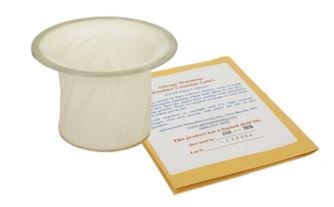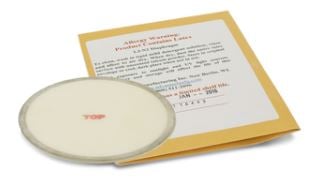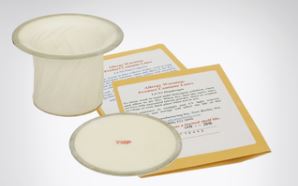How To Maintain a Sonic Sifter: Fine Particles Collector and Diaphragm
If you are a lab manager or lab operator working within the particle size analysis industry, you know that the results you achieve are only as good as the equipment used to obtain them. This is universal no matter what form of particle analysis you use.
That said, the best practices you implement will vary depending on the process you use to test your material. For example, the way you maintain a RO-TAP® Sieve Shaker will be different from how you maintain the many components of a sonic sifter separator as the sonic sifter must employ latex pieces, specifically the fine particles collector and diaphragm, to facilitate its unique functionality.
So, how exactly should you handle and maintain these latex components to extend their life and minimize downtime?
W.S. Tyler has helped customers make the most of their particle analysis, helping various operations across an even larger set of industries remain in tip-top shape.
But for those looking to maintain a successful sonic sifter analysis, this article will help you ensure the latex components last as long as possible. To educate you on how to properly handle and maintain the fine particles collector and diaphragm of a sonic sifter separator, we will be discussing the following:
- The purpose of the fine particles collector and diaphragm
- The best practices you should employ when handling fine particles collector and diaphragm
- Steps you can take to extend the lifespan of your latex components
Understanding the Functions of the Fine Particles Collector and Diaphragm
In order to facilitate a successful sonic sifter analysis, the sonic sifter separator employs an oscillating motion to create a sonic wave that travels through the test sieve stack, working to separate particles and help them find the openings in the mesh. Additionally, there is a vertical tapping motion that can be toggled on and off to further help break down particle agglomeration.
To that end, the unique sonic wave that is present when testing is made possible as the two key components, the fine particles collector and the diaphragm, are made of a latex material.
Fine Particles Collector

The fines particles collector is a latex pocket located at the bottom of the test sieve stack designed to catch any particles that may pass through the finest test sieve in your test sieve stack. Additionally, its latex makeup allows the oscillating motion to occur without limitations, amplifying the sonic wave that pushes up through the sieve stack.
Diaphragm

The diaphragm is the latex disc that rests on top of the test sieve stack, blocking the sonic wave from projecting the particles on the top-most sieve out of the stack. It is made out of latex in order to work collaboratively with the sonic wave and help promote particle movement throughout the sieve stack.
How Do I Best Maintain My Fine Particles Collector and Diaphragm
Maintaining your particles collector and diaphragm mainly entails how you clean them after each use. To clean, pair lukewarm water and a mild detergent as a cleaning solution and rinse clean in water.
After cleaning, both pieces should be set out to air dry. To that end, forced air and heat should be avoided during the cleaning process as this has the potential to damage the latex makeup.
Use an unscented talcum powder to coat the dry latex surfaces before placing it in its rightful storage envelope. When testing is done, and the pieces are clean, you should store them in a cool, dry, dark location, making sure not to stack anything on them.
How Do I Prolong the Life Span of My Fine Particles Collector and Diaphragm
Both the fine particles collector and diaphragm share identical shelf lives of 14 months after the day of manufacturing. That said, there are some best practices you should employ to ensure you make the most out of these 14 months.
It is recommended to have multiples of each component. As rest time between testing can reduce wear and tear, allowing you to rotate fine particles collectors and diaphragms between uses.
You should also be sure to prevent the latex surfaces from enduring heat, sunlight, and UV light for extended periods of time. This is due to the fact that these factors are known to alter the integrity of the latex properties.
Keep Your Particle Analysis Equipment in Running Condition for Years To Come
The fines particles collector and diaphragm are latex components used to facilitate the oscillating motion that sonic sifter separators use to create the sonic wave needed to promote particle movement. But because they’re latex, you must use care when cleaning and handling them, making sure to store them in a dry, safe location to ensure you make the most out of the 14-month expected lifespan of each component.
But now that we have some best practices out in the open, let’s address the elephant in the room and agree that most if not all particle analysis operations are the same. This means that the particle analysis organization you choose to work with should treat your case with individual care.
W.S. Tyler takes pride in knowing that our customers receive a tailored experience. We accomplish this feat by taking the time to understand how each of our customers’ processes works, assessing and presenting all possible solutions.
As the way you handle and maintain the fine particles collector and diaphragm are just the tip of the iceberg, we encourage you to use one of the following avenues to contact us with any questions or concerns regarding your sonic sifter analysis setup:
- Go to our Contact Us page and fill out the form
- Email your configuration and contact information to our sales team at info@wstyler.com
- Reach out to us via phone at 800-321-6188
- Provide our interactive chatbot (lower right-hand corner of this page) with your credentials and specific configuration needs
About Ronnie Brown
Ronnie is the Content Writer for W.S. Tyler and has four years of experience as a professional writer. He strives to expand his knowledge on all things particle analysis and woven wire mesh to leverage his exceptional writing and graphic design skills, creating a one-of-a-kind experience for customers.




